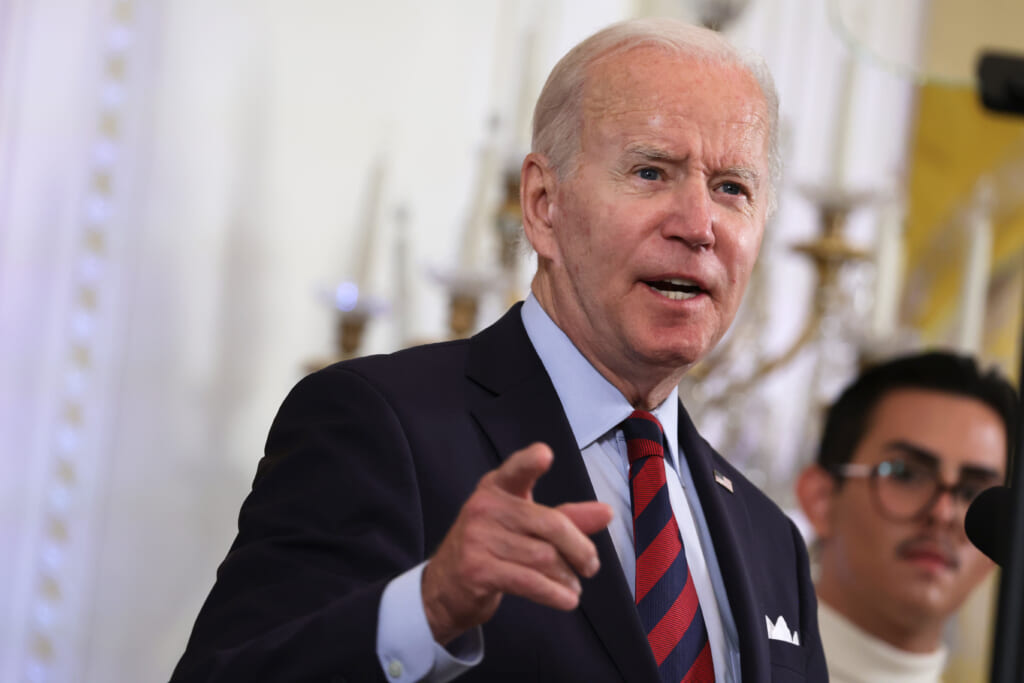Why voters of color need President Biden to make a comeback
OPINION: We need this White House to succeed because we’d simply like to survive a little bit longer without the threat of a white supremacist running the country—again.

Editor’s note: The following article is an op-ed, and the views expressed are the author’s own. Read more opinions on theGrio.
President Joe Biden is undoubtedly at his lowest point politically, with some polls showing him at lows it took Donald Trump two impeachments to reach. And the floor hasn’t even entirely dropped out. If things continue to trend in the direction they appear to be, Biden could be entering 2023 at 80 years old with a Republican House and Senate and the Democratic Party loudly asking him to step aside in favor of a different nominee in 2024.
How did things get so dire so quickly? There are myriad factors—many of which, sadly, are beyond Biden’s control. But there has also been a fair share of self-inflicted wounds, especially when it comes to catering to the very voters who made his presidency possible—people of color.
Now, it’s very popular to beat up on Biden these days, and before joining the chorus, it’s worth pointing out that his administration has a lot to be proud about. Unemployment is historically low, a huge portion of the population has been efficiently vaccinated for COVID-19, and his White House has scored several impressive legislative achievements, including the first significant gun control bill in decades, a major infrastructure package and the successful confirmation of the first Black female Supreme Court justice in history, just to name a few.
There’s not a day that goes by where millions of Americans are not grateful that Donald Trump is no longer president and Biden’s inauguration—which featured a breakout performance by poet Amanda Gorman—was a genuinely cathartic reminder of how precious our fragile democracy still is. The first five to six months of Biden’s presidency—with the swift passage of a massive COVID relief bill and a slew of high-profile executive orders—perhaps created a false impression of an ambitious administration on the move, even drawing comparisons to the transformative tenure of FDR.
But then calamity after calamity piled up—COVID’s resurgence, a botched withdrawal from Afghanistan, rising inflation and gas prices, spikes in violent crime, the overturning of Roe v. Wade and much more—and the Biden White House couldn’t escape the impression that they were hopelessly held captive to events instead of taking the lead on them.

Months of political capital were wasted trying to persuade two conservative Democratic senators to abandon an archaic Senate rule with racist roots, which prevented much of the incredibly popular agenda Biden ran on from getting passed. For voters of color, who formed the backbone of the coalition that put him into office, his presidency began to feel like Lucy and the football from the old Peanuts cartoon. There would be the promise of voting rights—only to see it fail. There would be the promise of police reform—only to see it go nowhere. And there was the explicit promise of student debt relief, which was well-documented to disproportionately be beneficial to people of color but has somehow still not happened despite constant reporting that relief was on the way.
To be sure, small gestures like codifying Juneteenth and signing a long overdo anti-lynching law were appreciated. And the Biden White House is to be commended for its incredibly diverse judicial appointments and cabinet, including the first female vice president of color, Kamala Harris.
But most people of color—many of whom had to wait hours in the midst of a pandemic in order to cast their votes—did not simply want to make the Trump administration go away; they also wanted to get something more in return.
Voters of color aren’t naive—they understand that pragmatism often has to take the place of passion and that there are definitely situations where a rising tide does lift all ships. But sometimes you also have to show not just tell what you’re trying to do and what your priorities are. And most importantly, who you are fighting for, which is where Biden and this White House are sorely lacking.

Who could follow Joe Biden?
This, frankly, comes as something of a surprise since so much of Biden’s team are veterans of the Obama White House. Even Obama would concede that on several fronts he fell short of the expectations voters had for him, but there’s a reason why he almost never struggled when it came to convincing a broad swath of voters that he was on their side. Most Americans not only liked him personally but, especially in his second term, saw him as fighting valiantly on the right side of most issues with a vigor that met the moment.
It’s hard to imagine Barack Obama ever delivering remarks as tepid and insubstantial as Biden’s following the SCOTUS decision to turn over Roe v. Wade, especially considering that they had several weeks to prepare for it. It’s not enough to excuse Biden’s comparatively weaker ability to deliver a speech; he’s proven he’s very effective at conveying empathy and emotion when it’s called for, and it was oddly lacking at a crucial inflection point.
Like with so many life-altering decisions, SCOTUS’s ruling will have a disproportionately negative impact on women of color, but that wasn’t acknowledged nor was there much of a plan of action besides imploring people to turn out and vote—again. Still, Biden didn’t have the worst response—that prize could go to either House Speaker Nancy Pelosi (who read a poem) or a group of Democrats who sang “God Bless America” on the steps of the Capitol—but it highlighted a consistent and fair critique of the Biden presidency.
Why should we fight for you if we don’t feel like you’re fighting for us?
Sometimes that feeling is more about style than substance. Obama singing “Amazing Grace” after the slaughter of nine innocent people at Mother Emanuel in South Carolina didn’t bring those people back or help move the ball on gun control, but it still sent a powerful message to the country that the hopeful swagger his administration represented for so many Americans would be resilient in the face of almost incomprehensible hate.
Ironically enough, this is part of Trump’s Svengali-like stranglehold on his supporters. Whether he is or not, Trump never stops reminding them that he’s on their side and he isn’t afraid to pick fights with the people to whom they are diametrically opposed. And while no one is asking Biden to be similarly vicious with his rhetoric, it would be nice if he seemed more invested in articulating a case for democracy than he is sending out fundraising emails.
For voters of color, whether they have affection for Biden or not is irrelevant. He remains, as of right now, the one thing standing between them and the fascist neo-dictatorship bent on revenge that a second Trump term promises to be. We need this White House to succeed not because we’re invested in any one man’s legacy but because we’d simply like to survive a little bit longer without the threat of a white supremacist running the country—again.
There has to be a significant erosion of support from your own political base to reach the dismal numbers Biden has begun to hit. This was a president who, believe it or not, was once tiptoeing around 60 percent approval just a year or so ago, so it stands to reason that at least some of those people can be brought back into the fold. But a pivot to the right—which would be the predictable and feckless reaction to a Republican rout this fall—will not increase his political fortunes.
Instead, Biden should make every effort to win back the trust and support of the rank-and-file people, many of whom held their noses when pulling his lever, with the time he has left in office. He once promised to be a “bridge” as a president to another generation of politicians, but so far Vice President Harris has been largely neutralized as a political force. And opportunities to galvanize public support for issues like police reform following the tragic death of Jayland Walker have been ineptly squandered. Between now and 2024 there may not be many more opportunities to not just capture the public’s attention but to persuade them that Biden can still be a leader of consequence.
We learned the hard way in 2016 what happens when millions of voters of color feel uninspired and taken for granted. The difference is this time, if the same thing happens again, none of us would get a chance to course correct again.

Adam Howard is a senior associate producer for “Full Frontal with Samantha Bee” and a producer on the “Full Release with Samantha Bee” podcast. He has written about pop culture, sports and politics for The Daily Beast, Playboy, and NBC News and has recently curated an exhibition of the history of blaxploitation for the Poster House museum in New York City.
TheGrio is FREE on your TV via Apple TV, Amazon Fire, Roku, and Android TV. Please download theGrio mobile apps today!











